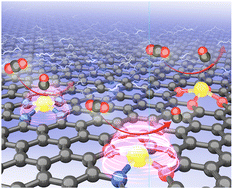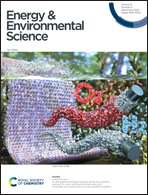Atomic-level engineering Fe1N2O2 interfacial structure derived from oxygen-abundant metal–organic frameworks to promote electrochemical CO2 reduction†
Abstract
Atomically-precise preparation and atomic-level understanding of the single-atomic active sites with unique coordination structures in electrocatalysts for the CO2 reduction reaction (CO2RR) remain a challenge. Here, we report a strategy of nitrogen (N) source-assisted pyrolysis of an oxygen-abundant MOF precursor (MOF-74) to give uniform, atomically-precise Fe sites, which consist of each Fe central atom coordinated simultaneously with two oxygen (O) atoms and two N atoms, and are anchored on N-doped carbon (thus denoted as Fe1N2O2/NC). By in situ synchrotron X-ray absorption spectroscopy, we have monitored the evolution of coordination structures of Fe atoms (in terms of coordinating atoms and coordination number) along with the increasing pyrolysis temperature. The obtained electrocatalyst exhibits a high selectivity with the faradaic efficiency for CO above 95% over a wide potential range from −0.4 to −0.8 V (in particular, 99.7% at −0.5 V), and a robust durability. Theoretical simulations demonstrate that the ratio of the numbers of coordinating N and O around Fe is very important for regulating the catalytic activity and selectivity of CO2-to-CO conversion. Compared with mono-coordinated Fe sites, the N2O2-coordinated Fe sites have lower free energy change for the steps of COOH* formation and CO desorption, resulting in accelerated reaction kinetics and elevated catalytic activity. This work provides an efficient strategy to prepare well-defined single-atomic active sites via high-precision manipulation of coordinating atoms to boost the catalytic performances for the CO2RR.



 Please wait while we load your content...
Please wait while we load your content...